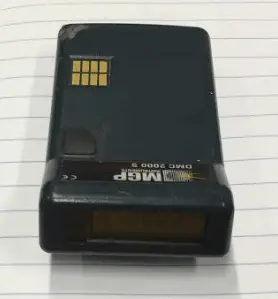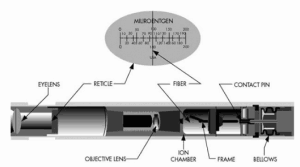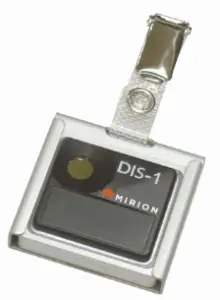A radiation dosimeter is a device that measures exposure to ionizing radiation. Dosimeters usually record a dose, the absorbed radiation energy measured in grays (Gy), or the equivalent dose measured in sieverts (Sv). A personal dosimeter is a dosimeter worn at the body’s surface by the person being monitored and records the radiation dose received.

Commercially available dosimeters range from low-cost, passive devices that store personnel dose information for later readout to more expensive, battery-operated devices that display immediate dose and dose rate information (typically an electronic personal dosimeter). Readout method, dose measurement range, size, weight, and price are important selection factors.
There are two kinds of dosimeters:
- Passive Dosimeters. Commonly used passive dosimeters are the Thermo Luminescent Dosimeter (TLD) and the film badge. A passive dosimeter produces a radiation-induced signal stored in the device, and the dosimeter is then processed, and the output is analyzed.
- Active Dosimeters. You can use an active dosimeter, typically an electronic personal dosimeter (EPD), to get a real-time exposure value. An active dosimeter produces a radiation-induced signal and displays a direct reading of the detected dose or dose rate in real-time.
The passive and the active dosimeters are often used together to complement each other. Dosimeters must be worn on a position of the body representative of its exposure to estimate effective doses, typically between the waist and the neck, on the front of the torso, facing the radioactive source. Dosimeters are usually worn outside clothing, around the chest or torso to represent dose to the “whole body.” Dosimeters may also be worn on the extremities or near the eye to measure equivalent doses to these tissues.
Types of Dosimeters
There are many types of radiation dosimeters and detectors, each with limitations.
Film Badge Dosimeters
Film badges are small portable devices for monitoring cumulative radiation dose due to ionizing radiation. The principle of operation is similar to X-ray pictures. The badge consists of two parts: photographic film and a holder. The film is contained inside a badge. The piece of photographic film is sensitive material, and it must be removed monthly and developed. The more radiation exposure, the more blackening of the film. The blackening of the film is linear to the dose, and doses up to about 10 Gy can be measured.
See also: Film Badge Dosimeter
TLD – Thermoluminescent Dosimeter
A thermoluminescent dosimeter, abbreviated as TLD, is a passive radiation dosimeter that measures ionizing radiation exposure by measuring the intensity of visible light emitted from a sensitive crystal in the detector when the crystal is heated. The intensity of light emitted is measured by the TLD reader and depends upon the radiation exposure. Thermoluminescent dosimeters were invented in 1954 by Professor Farrington Daniels of the University of Wisconsin-Madison. TLD dosimeters apply to situations where real-time information is not needed. Still, precise accumulated dose monitoring records are desired for comparison to field measurements or for assessing the potential for long-term health effects.
See also: TLD – Thermoluminescent Dosimeter
EPD – Electronic Personal Dosimeter
An electronic personal dosimeter is a modern dosimeter that can give a continuous readout of cumulative dose and current dose rate and warn the person wearing it when a specified dose rate or a cumulative dose is exceeded. EPDs are especially useful in high-dose areas where the residence time of the wearer is limited due to dose constraints.
The electronic personal dosimeter, EPD, can display a direct reading of the detected dose or dose rate in real-time. Electronic dosimeters may be used as supplemental dosimeters as well as primary dosimeters. The passive and electronic personal dosimeters are often used together to complement each other.
See also: EPD – Electronic Personal Dosimeter
MOSFET Dosimeter
MOSFET dosimeter is a small portable device for monitoring and direct reading radiation dose rate. Since it is based on the MOSFET transistor, the metal-oxide-semiconductor field-effect transistor (MOSFET), the principle of operation is similar to semiconductor detectors. MOSFET dosimeters are now used as clinical dosimeters for radiotherapy radiation beams. Their main advantage is their physical size, which is less than 4 mm2. In radiation therapy dosimetry, MOSFET dosimeters often replace TLD dosimeters since they offer immediate readout.
See also: MOSFET Dosimeter
Self-reading Dosimeter

Self-reading dosimeters are field-readable devices worn on the body to measure an accumulated dose. These are unpowered devices that do not contain a battery. Devices in this group include:
- Quartz fiber dosimeter. A quartz fiber dosimeter, called a self-indicting pocket dosimeter (SIPD), is a pen-like device that measures the cumulative dose of ionizing radiation received by the device, usually over one work period.
- Self-developing photochemical cards. The self-developing photochemical card is a credit card-sized, instant color-developing emergency dosimeter. It is designed to monitor exposure in a radiological incident for medical treatment triage and minimize worry and panic.
See also: Self-reading Dosimeter
DIS Dosimeter

Direct-ion storage dosimeter, DIS, is an electronic dosimeter from which the dose information for both Hp(10) and Hp(0.07) can be obtained instantly at the workplace using an electronic reader unit. The DIS dosimeter is based on the combination of an ion chamber and a non-volatile electronic charge storage element. DIS dosimeter uses an analog memory cell inside a small, gas-filled ionization chamber. Incident radiation causes ionizations in the chamber wall and the gas, and the charge is stored for subsequent readout. The DIS dosimeter is read at the user’s site by connecting to an electronic reader unit.